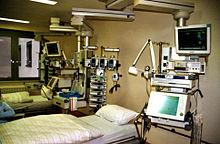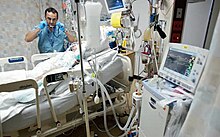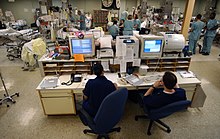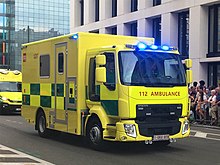Intensive care unit
ICU patients often require mechanical ventilation if they have lost the ability to breathe normally.
An intensive care unit (ICU), also known as an intensive therapy unit or intensive treatment unit (ITU) or critical care unit (CCU), is a special department of a hospital or health care facility that provides intensive treatment medicine.
Intensive care units cater to patients with severe and life-threatening
illnesses and injuries, which require constant care, close monitoring
and support from specialist equipment and medications in order to ensure
normal bodily functions. They are staffed by highly trained doctors and nurses
who specialize in caring for critically ill patients. ICUs are also
distinguished from normal hospital wards by a higher staff-to-patient
ratio and access to advanced medical resources and equipment that is not
routinely available elsewhere. Common conditions that are treated
within ICUs include acute (or adult) respiratory distress syndrome (ARDS), trauma, multiple organ failure and sepsis.
Patients may be transferred directly from an emergency department
if required, or from a ward if they rapidly deteriorate, or immediately
after surgery if the surgery is very invasive and the patient is at
high risk of complications.
History
In 1854, Florence Nightingale left for the Crimean War, where triage was used to separate seriously wounded soldiers from the less-seriously wounded.
Until recently (DJS: what is it now?), it was reported that Nightingale reduced mortality from 40% to 2% on the battlefield.
Although this was not the case, her experiences during the war
formed the foundation for her later discovery of the importance of
sanitary conditions in hospitals, a critical component of intensive
care.
In 1950, anesthesiologist Peter Safar established the concept of "Advanced Support of Life", keeping patients
sedated and ventilated in an intensive care environment. Safar is
considered to be the first practitioner of intensive care medicine as a
specialty.
In response to a polio epidemic (where many patients required constant ventilation and surveillance), Bjørn Aage Ibsen established the first intensive care unit in Copenhagen in 1953.
The first application of this idea in the United States was in 1955 by William Mosenthal, a surgeon at the Dartmouth-Hitchcock Medical Center. In the 1960s, the importance of cardiac arrhythmias as a source of morbidity and mortality in myocardial infarctions (heart attacks) was recognized. This led to the routine use of cardiac monitoring in ICUs, especially after heart attacks.
Staffing
- Most studies addressing staffing of ICUs have had significant limitations, and this literature does not yet provide a consistent view of the best model to use. This subject is complicated by the fact that optimal ICU staffing may depend on ICU characteristics.
- Despite calls for all ICUs to function as closed-model units with intensivists as the primary physician of record, evidence supporting this view is contradictory. Likewise, studies of around-the-clock intensive presence have not consistently shown that it is associated with superior outcomes.
- The data do not supply a consistent answer to the question of whether ICUs would obtain better outcomes if they added nurses to reduce their patient:nurse ratios.
- Increasingly, nonphysician providers are playing innovative roles in the ICU, and care provided by teams including nurse practitioners or physician assistants appears to be safe and comparable to that provided by other staffing models.
- The conditions of ICU staffing will continue to change under the stresses of shortages of a variety of health care workers relevant to ICU care, and increasing duty hour limitations for physician trainees. Nonphysician providers, innovative staffing models, telemedicine, and other technologies will be increasingly used to cope with these realities.
- Since only quantitative evaluation can tell us whether one staffing model is better than another, we need more research from multiple sites to develop a consistent and integrated understanding of this complex topic.
Specialities
ICU Nurse attending to a patient in Baghdad, Iraq.
ICU
nurses monitoring patients from a central computer station. This allows
for rapid intervention should a patient's condition deteriorate whilst a
member of staff is not immediately at the bedside.
Nurses in a neonatal intensive care unit (NICU)
Hospitals may have ICUs that cater to a specific medical speciality or patient, such as those listed below:
- Neonatal intensive care unit (NICU). This specialty unit cares for neonatal patients who have not left the hospital after birth. Common conditions cared for include prematurity and associated complications, congenital disorders such as Congenital diaphragmatic hernia, or complications resulting from the birthing process.
- Pediatric intensive care unit (PICU). Pediatric patients are treated in this intensive care unit for life-threatening medical problems such as asthma, influenza, diabetic ketoacidosis, or traumatic brain injury. Surgical cases may also be transferred to the PICU postoperatively if the patient has a potential for rapid deterioration and requires more frequent monitoring, such as in spinal fusions or surgeries involving the airway such as removal of the tonsils or adenoids. Some facilities also have specialized pediatric cardiac intensive care units, where patients with congenital heart disease are cared for. These units also typically handle cardiac transplantation and post-op care of cardiac catheterization patients if those services are offered at the hospital.
- Psychiatric intensive care unit (PICU). Patients who may voluntarily harm themselves are delivered here so they can be monitored more vigorously.
- Coronary care unit (CCU): Also known as Cardiac Intensive Care Unit (CICU) or Cardiovascular Intensive Care Unit (CVICU), this ICU caters to patients specifically with congenital heart defects or life-threatening acute conditions such as cardiac arrest.
- Neurological intensive care unit (NeuroICU). Patients here are treated for aneurysms, brain tumors, stroke, rattlesnake bites and post surgical patients who have undergone various neurological surgeries and require hourly neurological exams. Many nurses who work within these units have neurological intensive care certifications. Once the patients are more stable and off the ventilator, they are transferred to a neurological care unit.
- Trauma intensive care unit (Trauma ICU). These are found only in hospitals certified in Trauma and have a dedicated Trauma Emergency Department equipped with a team of surgeons, nurses, respiratory therapists, and radiological staff.
- Post-anesthesia care unit (PACU): Also known as the post-operative recovery unit, or recovery room, the PACU provides immediate post-op observation and stabilization of patients following surgical operations and anesthesia. Patients are usually held in such facilities for a limited amount of time, and must meet a set physiological criteria before transfer back to a ward with a qualified nurse escort. Due to high patient flow in recovery units, and owing to the bed management cycle, if a patient breaches a time frame and is too unstable to be transferred back to a ward, they are normally transferred to a high dependency unit (HDU) or post-operative critical care unit (POCCU) for closer observation.
- High dependency unit (HDU): In the United Kingdom and elsewhere (known as step down unit or progressive care unit in North America), most acute hospitals have a transitional high dependency unit (HDU) for patients who require close observation, treatment and nursing care that cannot be provided on a general ward, but whose care is not at a critical enough level to warrant an ICU bed. These units are also called step-down, progressive and intensive recovery units and are utilized until a patient's condition stabilizes enough to qualify them for discharge to a general ward.
- Surgical intensive care unit (SICU): A specialized service in larger hospitals that provides inpatient care for critically ill patients on surgical services. As opposed to other ICUs, the care is managed by surgeons trained in critical-care.
Out of hospital ICU
The MICU is a specialized ambulance
with the staff and equipment to provide on-scene Advanced Life Support
resuscitation and intensive care during transport. These type of ICUs
are generally for people who are being transferred between hospitals and
not from home to a hospital. In the Anglo American model of
pre-hospital care MICUs are generally paramedic crewed. In the European
model Mobile ICU crews are usually a specialized nurse and an emergency
medicine physician.
Equipment and systems
Common equipment in an ICU includes mechanical ventilators to assist breathing through an endotracheal tube or a tracheostomy tube; cardiac monitors including those problems; equipment for the constant monitoring of bodily functions; a web of intravenous lines, feeding tubes, nasogastric tubes, suction pumps, drains, and catheters; and a wide array of drugs to treat the primary condition(s) of hospitalization. Medically induced comas, analgesics, and induced sedation are common ICU tools needed and used to reduce pain and prevent secondary infections.
Quality of care
The available data suggests a relation between ICU volume and quality of care for mechanically ventilated patients. After adjustment for severity of illnesses, demographic
variables, and characteristics of different ICUs (including staffing by
intensivists), higher ICU staffing was significantly associated with
lower ICU and hospital mortality rates.
A ratio of 2 patients to 1 nurse is recommended for a medical ICU,
which contrasts to the ratio of 4:1 or 5:1 typically seen on medical
floors. This varies from country to country, though; e.g., in Australia
and the United Kingdom most ICUs are staffed on a 2:1 basis (for
high-dependency patients who require closer monitoring or more intensive
treatment than a hospital ward can offer) or on a 1:1 basis for
patients requiring very intensive support and monitoring; for example, a
patient on a mechanical ventilator with associated anaesthetics or
sedation such as propofol, midazolam and use of strong analgesics such as morphine, fentanyl and/or remifentanil.
In the ICU, international guidelines recommend that every patient
gets checked for delirium every day (usually twice or more a day) using
a validated clinical tool. The two most widely used are the Confusion
Assessment Method for the ICU (CAM-ICU) and the Intensive Care Delirium
Screening Checklist (ICDSC). There are translations of these tools in
over 20 languages and they are used globally in many thousands of ICUs.
Operational logistics
In
the United States, up to 20% of hospital beds can be labelled as
intensive-care beds; in the United Kingdom, intensive care usually will
comprise only up to 2% of total beds. This high disparity is attributed
to admission of patients in the UK only when considered the most
severely ill.
Intensive care is an expensive healthcare service. A recent
study conducted in the United States found, hospital stays that involved
ICU services were 2.5 times more costly than other hospital stays.
In the United Kingdom, the average cost of funding an intensive care unit is:
- £838 per bed per day for a neonatal intensive care unit
- £1,702 per bed per day for a pediatric intensive care unit
- £1,328 per bed per day for an adult intensive care unit
Remote collaboration systems
Some
hospitals have installed teleconferencing systems that allow doctors
and nurses at a central facility (either in the same building, at a
central location serving several local hospitals, or in rural locations
another more urban facility) to collaborate with on-site staff and speak
with patients (a form of telemedicine). This is variously called an eICU, virtual ICU, or tele-ICU.
Remote staff typically have access to vital signs from live monitoring
equipment, and to electronic health records so they can get a broader
view of a patient's medical history. Often bedside and remote staff have
met in person and may rotate responsibilities. Such systems allow
hospitals to double-check that correct procedures are being followed for
the patients most vulnerable to mistakes, and to access expertise
remotely to keep patients that would otherwise have to be transferred to
a larger facility, and have demonstrated a significant decrease in
mortality.






